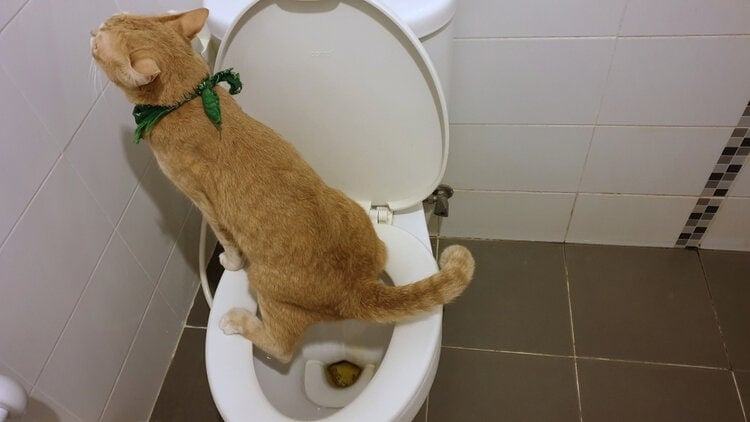Almost everyone is bound to have their private opinion involving Can You Flush Cat Poop Down The Toilet?.

Introduction
As pet cat owners, it's vital to be mindful of exactly how we dispose of our feline close friends' waste. While it may seem hassle-free to purge cat poop down the bathroom, this practice can have damaging effects for both the atmosphere and human health and wellness.
Ecological Impact
Flushing feline poop presents harmful pathogens and bloodsuckers right into the water, posing a considerable risk to water ecological communities. These impurities can negatively impact marine life and compromise water quality.
Health Risks
Along with environmental problems, purging feline waste can additionally position health risks to human beings. Pet cat feces might include Toxoplasma gondii, a parasite that can cause toxoplasmosis-- a potentially severe illness, specifically for expecting women and people with damaged body immune systems.
Alternatives to Flushing
Luckily, there are more secure and more liable means to dispose of feline poop. Consider the following options:
1. Scoop and Dispose in Trash
One of the most usual method of disposing of pet cat poop is to scoop it right into a naturally degradable bag and throw it in the trash. Be sure to utilize a specialized clutter scoop and get rid of the waste without delay.
2. Usage Biodegradable Litter
Select naturally degradable cat litter made from materials such as corn or wheat. These clutters are environmentally friendly and can be safely dealt with in the trash.
3. Bury in the Yard
If you have a lawn, take into consideration burying pet cat waste in a designated area far from veggie yards and water resources. Make sure to dig deep enough to stop contamination of groundwater.
4. Set Up a Pet Waste Disposal System
Invest in a pet garbage disposal system particularly made for feline waste. These systems utilize enzymes to break down the waste, reducing smell and environmental influence.
Final thought
Responsible pet dog ownership prolongs beyond offering food and sanctuary-- it additionally includes correct waste management. By avoiding flushing pet cat poop down the toilet and selecting alternative disposal approaches, we can reduce our ecological footprint and safeguard human wellness.
Why Can’t I Flush Cat Poop?
It Spreads a Parasite
Cats are frequently infected with a parasite called toxoplasma gondii. The parasite causes an infection called toxoplasmosis. It is usually harmless to cats. The parasite only uses cat poop as a host for its eggs. Otherwise, the cat’s immune system usually keeps the infection at low enough levels to maintain its own health. But it does not stop the develop of eggs. These eggs are tiny and surprisingly tough. They may survive for a year before they begin to grow. But that’s the problem.
Our wastewater system is not designed to deal with toxoplasmosis eggs. Instead, most eggs will flush from your toilet into sewers and wastewater management plants. After the sewage is treated for many other harmful things in it, it is typically released into local rivers, lakes, or oceans. Here, the toxoplasmosis eggs can find new hosts, including starfish, crabs, otters, and many other wildlife. For many, this is a significant risk to their health. Toxoplasmosis can also end up infecting water sources that are important for agriculture, which means our deer, pigs, and sheep can get infected too.
Is There Risk to Humans?
There can be a risk to human life from flushing cat poop down the toilet. If you do so, the parasites from your cat’s poop can end up in shellfish, game animals, or livestock. If this meat is then served raw or undercooked, the people who eat it can get sick.
In fact, according to the CDC, 40 million people in the United States are infected with toxoplasma gondii. They get it from exposure to infected seafood, or from some kind of cat poop contamination, like drinking from a stream that is contaminated or touching anything that has come into contact with cat poop. That includes just cleaning a cat litter box.
Most people who get infected with these parasites will not develop any symptoms. However, for pregnant women or for those with compromised immune systems, the parasite can cause severe health problems.
How to Handle Cat Poop
The best way to handle cat poop is actually to clean the box more often. The eggs that the parasite sheds will not become active until one to five days after the cat poops. That means that if you clean daily, you’re much less likely to come into direct contact with infectious eggs.
That said, always dispose of cat poop in the garbage and not down the toilet. Wash your hands before and after you clean the litter box, and bring the bag of poop right outside to your garbage bins.
https://trenchlesssolutionsusa.com/why-cant-i-flush-cat-poop/

Do you enjoy reading up on How to Dispose of Cat Poop and Litter Without Plastic Bags? Create feedback further down. We will be interested to see your views about this blog entry. We are looking forward that you visit us again soon. So long as you enjoyed our blog entry kindly be sure to share it. Bless you for your time. Please come by our site back soon.
Click Here